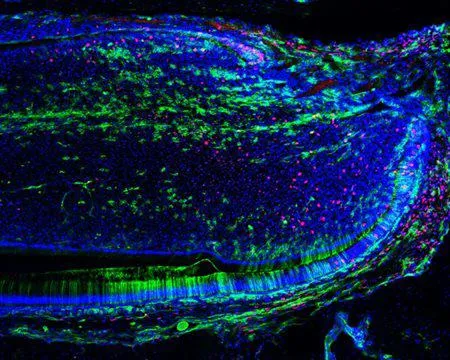25 January 2018
Study finds how to activate stem cell growth from reserves
Stem cells provide renewable sources of cells in many adult tissues, enabling tissue growth and repair. But what happens when the stem cells themselves become depleted, or the tissue needs to go through periods of more rapid growth?

Stem cells dividing in the tooth (red) and differentiating into specialised tooth cells, odontoblasts (green) and tooth pulp cells.
A recent study by researchers at King’s College London’s Dental Institute have showed that in growing teeth, a tiny population of cells act as an emergency reservoir and these can provide new stem cells during rapid tooth growth. The study was recently published in Nature Communications.
The team, led by Professor Paul Sharpe, found that these normally quiescent cells become activated at times when the tooth needs a growth spurt. They generate a specific population of stem cells that provide the extra cells needed for the increase in growth rate.
The research has implications for understanding how stem cells behave and which cell populations may need to be targeted in clinical therapies. By knowing which stem cells to activate to encourage rapid growth, the research takes another step towards enabling the natural repair of teeth.
Notes:
“A quiescent cell population replenishes mesenchymal stem cells to drive accelerated growth in mouse incisors” to be published in Nature Communications on 25 January 2018, 10.00 GMT. It can be viewed here: https://www.nature.com/articles/s41467-017-02785-6
Professor Paul Sharpe is the Head of the Centre of Craniofacial and Regenerative Biology at King’s College London Dental Institute.

